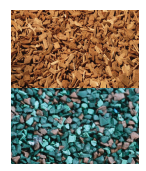By Chris Kittleson, Certified Playground Safety Inspector (CPSI), Director of Loss Control Technical Services - Public Risk Underwriters of Florida, Inc.

The playground is a place where children run, laugh, take risks and explore possibilities. It is a place where imagination and spontaneity rule the moment and where play claims a major role in childhood development. However, playgrounds can also be a source of injury when improperly designed or maintained.
As Risk Managers and Safety Professionals we all agree that playground injuries are preventable as well as a priority in order to protect our children from injury and/or death. According to the Center for Disease Control and Prevention (CDC), each year Hospital Emergency Rooms treat more than 200,000 children ages 14 and younger for playgroundrelated injuries that include traumatic brain injury (TBI), including concussions, as well as fractures, contusions and abrasions. In addition, between 2001 and 2008, the Consumer Product Safety Commission (CPSC) investigated 40 deaths associated with playground equipment. They found that the average age of children who died was six years old and that 27 (68%) died from strangulation and six (15%) died from falls to the playground surface.
Strangulations involve head/neck entrapment, such as wearing bicycle helmets on a playground which increases the size of the child’s head resulting in entrapment. Also, loose clothing and clothing with drawstrings that could catch on play equipment and become entangled can cause strangulation. In addition, cords such as jump ropes, dog leashes, or rope swing supports also have the potential for strangulation if left attached or near playground equipment.
There are many playground hazards that relate to equipment, the environment and the lack of supervision. The National Playground Safety Institute (NPSI) has identified these most common playground hazards which they refer to as the “Dirty Dozen” as follows:
• Improper Protective Surfacing
• Protrusion & Entanglement Hazards
• Insufficient Equipment Spacing
• Lack of Supervision
• Lack of Maintenance
• Platforms with No Guardrails
• Inadequate Use Zone
• Entrapment in Openings
• Trip Hazards
• Age-Inappropriate Activities
• Crush, Shearing and Share Edge Hazards
• Equipment Not Recommended for Public Playgrounds

An understanding of playground safety requires a review and understanding of some basic concepts which include the following:
AGE APPROPRIATENESS
Playgrounds should be appropriate for the age-related abilities of children. More specifically, toddlers, preschool and school-age children differ in their physical size, ability, intellect and social skills. Therefore age-appropriate playground equipment/design should accommodate these differences as it relates to type, scale and layout of playground equipment. Age groups for the purposes of playground safety are defined as “ toddlers”, which are children ages 6 months through 2 years of age, “preschool age”, which are children 2-5 years of age and “school age”, which are children 5-12 years of age.
INAPPROPRIATE PLAYGROUND EQUIPMENT
Some playground equipment is not recommended for use on public playgrounds and would include the following:
• Swinging Gates
• Multiple occupancy swings
• Climbing ropes that are not secured on both ends
• Rope Swings
• Animal-figure swings
• Trampolines

SURFACING
The surfacing under and around playground equipment can be a major factor in determining the severity of an injury caused by a fall. A fall onto a shock-absorbing surface is less likely to cause a serious injury than a fall onto a hard surface. Because headimpact injuries from a fall have the potential for being life-threatening, the more shock absorbing material a surface has, the greater the likelihood of reducing a severe injury. Manufacturers and installers of playground protective surfacing should provide the critical height rating of their materials to assist in determining the required depth of protective material around each piece of playground equipment. Examples of acceptable/unacceptable surfacing are as follows:
Acceptable Surfaces
• Engineered Wood Fiber
• Wood Chips
• Sand/Pea Gravel
• Synthetic/Rubber Tires
• Rubbers Mats
• Unitary Surface (poured rubber material)

Unacceptable Surfaces
• Concrete
• Blacktop
• Packed Earth
• Grass

ADULT SUPERVISION
Young children are constantly challenging their own abilities without recognizing potential hazards that could lead to an injury. Supervision of children in playgrounds ensures age appropriate use of play equipment and helps in preventing injuries. If an injury does occur, the adult can ensure first aid/medical attention is provided immediately.
PROPER MAINTENANCE
To provide a safe playground, a systematic preventative maintenance schedule must be developed, implemented and enforced to include the following:
• There should be no missing, broken or worn-out components
• All hardware should be secure
• The wood, metal or plastic should show no signs of fatigue or deterioration
• All parts should be stable with no apparent signs of loosening
• Surfacing materials must be maintained
• Check for signs of vandalism

REGULAR INSPECTION
Providing regular documented playground inspections helps in keeping the playground safe by identifying unsafe conditions caused by wear and tear, vandalism, breakage, storm damage, litter as well as other environmental concerns, i.e. flooding and stinging insects. In addition, playground inspections are essential in order to maintain the standard of care as a means to reduce the potential for liability. Playground inspections should be completed by trained staff, tailored to type of equipment and surfacing, designed to document both problem and corrective action and documented with easy-to-use checklist/forms based on Manufacturer’s recommendations as well as the Owner’s policies and procedures. Inspection protocol can be characterized as either Low Frequency, which is preventative maintenance, such as monitoring the depth of wood mulch or High Frequency, which is routine maintenance, such as replacing worn “S” hooks on swings.
ENVIRONMENTAL HAZARDS
Protecting the playground area from sun provides a dual benefit. Shading the playground from the sun provides a cooler play area, reducing the potential for heat related illness as well as prevents playground equipment from reaching high temperatures which could result in burns to the skin. Shading can be provided either through the use of the natural landscaping or shades designed by Manufacturers to assist in mitigating these sun related hazards.
